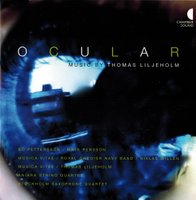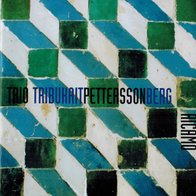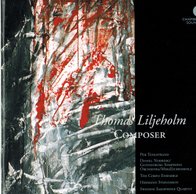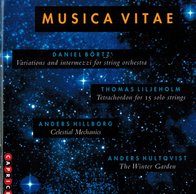REVIEWS
OCULAR (CD PORTRAIT)
CHAMBER SOUND/CSCD08038/CDA
Bo Pettersson, basse clarinet; Mats Persson, piano / Musica Vitae String orchestra; Royal Swedish Navy Band; Cond. Niklas Willén / Musica Vitae String orchestra; Ragnar Arnberg, clarinet and bass clarinet; Philip Foster, french horn; Sebastian Wagner, bassoon and contra bassoon: Cond. Thomas Liljeholm / Aniara String Quartet / Stockholm Saxophone Quartet
The CD opens with the title track – “Ocular” – for piano and bass clarinet. It begins in strength by pushing the bass clarinet up to its highest register where it stays for a minute or so at a height expanded by microtones before dropping precipitously to the bass range. These register extremes take turns in a rapid alteration as the piece progresses. The tonal color shifts as well enabling the bass clarinet to use its entire arsenal of unique playing techniques frequently placed in exciting musical contexts. The piece gains urgency through its restlessly syncopated melodies at times interrupted by calmer segments. Seen as a whole, the music leaves an improvisational, somewhat liquid impression, even though the intensity remains high…
“Bass and Pendulum” should be seen as the CD’s apex. Composed for the string orchestra Musica Vitae and the brass instruments of the Royal Swedish Navy Band, it is an interesting, though a seemingly difficult combination to blend. Still there are no cracks in the seams between the ensembles. Liljeholm quickly establishes a dark and sometimes anguished mood …
A Schubert-style octet comprising clarinet, bassoon, French horn and strings, “Origo” is a much calmer piece. After a few initial timbre changes against a background of an extended G Sharp, the piece sways on through searching, tentative characteristics …
The instrumentation is sensitive and the rich variation that at times suggests a much larger ensemble make the piece well worth listening to …
“Bifraction” for string quartet is, as the title suggests, a piece that breaks into two clear parts. The first begins with a self-assured violin segment accentuated by asymmetrical pizzicati, but the confidence stumbles and the music descends into fumbling dissonant glissandi … Then, after a chanting, climactic closing, the music moves into the artless tonal calm of the second part …
The last piece on the CD has the curious title “Interaction, Tulegatan 53”, in fact the address in Stockholm’s Vasastaden city district of the Stockholm Saxophone Quartet. The piece is eclectic, throwing itself between textures ranging from highly dissonant heterophonics to swinging click-sound riffs in a low range …
The music is performed with marked sureness by all the ensembles. Overall the CD offers a strong, varied production that convincingly displays Thomas Liljeholm’s broad composition capacity.
Nutida Musik 4 / 2008 – 09
Axel Englund
LINK for flute, percussion and organ
(CD review)
Phono Suecia / PSCD 165
Trio Tribukait Pettersson Berg - RICAMO
Michael Pettersson, flute; Daniel Berg, marimba;
Bengt Tribukait, organ
At last Thomas Liljeholm’s “Link” offers a track of what I miss – a curiosity about timbres, the courage to let the sound breathe organically and some personality. It is lovely without leaving the feeling that you have eaten too much American cheesecake.
Nutida Musik 2 / -08
Mika Pelo
THOMAS LILJEHOLM – COMPOSER
(CD Portrait)
Chamber Sound / CSCD97020 /CDA
Per Tengstrand, piano / Daniel Norberg, solo percussion; Gothenburg Symphony Orchestra; Mika Eichenholz, conductor / Johan Westerlund, percussion; Jonas Landén, piano; Johan Ekenberg, double bass; Jerker Johansson, musical advisor / Hermann Stefansson, clarinet / Swedish Saxophone Quartet
Witnessing the word’s presence
In these works by Thomas Liljeholm, composer and Deus-ex-machina in Växjö’s Media Artes association, interval and rhythm are totally dissolved. This is not done in the service of deconstruction, but to clear the path for compositions with finely meshed musical nets whose constructural function primarily segues to the interwoven form of these compositions. However, this does not mean that intervals and rhythmic structures disappear in his music, but that they are ‘heard’ in another, most nearly unexpected succession.
The musical structure in “Breaking Out“ for piano and in “Corpo” for percussion, piano and double bass reminds me of Bartók in its shifts between a tight “classical” surface and jazz cadenzas à la Monk. However this is as a pattern, not as sonorities or musical quotes. Liljeholm’s composition is transformed by a meticulous musical calligraphy that joins a larger musical construct with a nearly elated attention to the individual movement of tones and colors.
“Tripod” for percussion and orchestra is a very interesting work based on various tempo indications used with theatrical dynamism as in “Corpo”. Here Liljeholm shifts between dark tones that most nearly parallels with a form of largo, segmented and adapted to a chamber music trio. The sonoral qualities of the Gamelan scale from Java and Bali is brought to mind in the percussion instruments, as well as to some extent in the piano. Combining the pianoforte and percussion creates a very lovely hybrid. “Corpo” is musically the best work in the collection.
“The Third Figure” for solo clarinet is a lovely, well-composed piece, written elegantly and very simply and lacking sentimental tones.
“A priori” for saxophone quartet is music that screams in a chiaroscuro lacking true contrasts or disparities. The contrasts are only seen as a “paper work” in the Barthian sense, defined by Roland Barthes as the zero point of the script or the relationship in filigree between the white untouched music paper and the composed music – an instant then between various moments.
The now, the composition process does not extinguish memory. The past and the world seem to disappear. Thomas Liljeholm’s music comprises other words, ones to which sonorities are not easily given, but which still are patiently waiting. His music seems to exist purely for witnessing the word’s presence.
Gränslöst Nr 3, sept. -99
Guido Zeccola
THOMAS LILJEHOLM – COMPOSER
(CD Portrait)
Chamber Sound / CSCD97020 /CDA
Per Tengstrand, piano / Daniel Norberg, solo percussion; Gothenburg Symphony Orchestra; cond. Mika Eichenholz / Johan Westerlund, percussion; Jonas Landén, piano; Johan Ekenberg, double bass / Jerker Johansson, musical advisor / Swedish
Saxophone Quartet.
Dramatic piano piece
Pianist Per Tengstrand leads us into a dramatic and exciting piano piece titled “Breaking Out”.
“Tripod” for solo percussion and orchestra is a multifaceted sonoral experience delivered by the Gothenburg Symphony Orchestra with Daniel Norberg as percussion soloist.
With an ensemble comprising percussion, piano and double bass, “Corpo” is a work that moves between the intuitive and intellectual in sharp, simple structures. The same concept forms the base for “The Third Figure” for solo clarinet. Liljeholm is indeed a composer with many interesting musical ideas.
Östgöta Correspondenten -98
Hans Wennering
Below, two reviews summarized into one.
Music by T. Haglund and T. Liljeholm.
TOMMIE HAGLUND – INIM-INIM
(CD Portrait)
Caprice CD / CAP 21522
John Ehde, cello; Joachim Gustafsson, violin; Tua Åberg, soprano;
Carl-Axel Dominiques, piano; Dan Almgren, violin m.fl.
THOMAS LILJEHOLM – COMPOSER
(CD Portrait)
Chamber Sound / CSCD97020 / CDA
Per Tengstrand, piano / Daniel Norberg, solo percussion; Gothenburg Symphony Orchestra; Mika Eichenholz, conductor / Johan Westerlund, percussion; Jonas Landén, piano; Johan Ekenberg, double bass; Jerker Johansson, musical advisor / Hermann Stefansson, clarinet / Swedish Saxophone Quartet.
Musical relationships need not exist on purely sonoral levels. The links might instead be found in the way the pieces are heard and the mood they create. Having listened to these highly interesting CDs it struck me how different musical styles can create reactions that are so similar.
Large gestures do not characterize Tommie Haglund’s music. Its touch is rather reflective and it is the small details that form the kernel from which the tones spring. They can be dreamily transcendent, as in Carl-Axel Dominique’s piano tones, but can as well open up to the warm romantic expressions in Dan Almgren’s violin. Central to this chamber music CD is “Spiráre Celorum”, played on a newly constructed instrument called clavisino. This electric clavichord raises the sound level and the tone thus developed is reminiscent of the delicate sensitivity of the Chinese guqin. The action moves slowly forward and the attention focuses on the relationships between sound and silence, between movement and rest.
At first Haglund’s music feels essentially different from Liljeholm’s. Where the former‘s musical flow and sound displays a softness, the latter’s expression is more angular and strident. By providing space for details in the musical room, Haglund reveals the structural event. Liljeholm, on the other hand, exposes deviations, thus more clearly exposing the musical foundation. This happens in the “Tripod“ concerto where percussion and orchestra develop their respective “lives” in a musical tug-of-war while they are a part of a close-knit symbiosis. In “The Third Figure” for solo clarinet (Hermann Stefansson) and “Corpo” for percussion, piano and double bass attention is focused on the sonoral and melodic foundations as they gain clarity through deviation.
Haglund and Liljeholm present the details of the musical essence in different ways. Their music is meditative, though in no way obvious. It calls for concentration, which they are well worth.
Dagens Nyheter -97
Andreas Engström
INTERACTION, Tulegatan 53
for saxophone quartet
(Concert review)
Kalv Festival, Kalv church
Stockholm Saxophone Quartet.
… The raw overtones from the Stockholm Saxophone Quartet crackled against the eardrums. Diana Rotaru’s “Fly in Amber” channeled a scream and a shade of krautrock and industry. Thomas Liljeholm’s “Interaction” cuts into the tougher expressionism with clean, straight lines that open to a hint of modus and chord under reconstruction. Here there is a more reflective tone perhaps more suitable to the room.
Nutida Musik 2 / 2013
Sofia Lilly Jönsson
TETRACHORDON for 15 solo strings
(Concert review)
Kristineberg, Växjö
Musica Vitae / Concert master Miranda Playfair / Cond. Peter Csaba.
As ready as can be
Under the leadership of Peter Csaba Musica Vitae’s preparations for the European tour are the best possible. This was made quite clear at its full-dress public rehearsal at Kristineberg last Sunday. A complete success!
With its strict form, sparse tone material and psychological ambiguity, Thomas Liljeholm’s “Tetrachordon” for 15 strings will certainly be a shocking experience for concert goers in Paris, Milan and Lisbon. The ensemble’s sonoral palette has broadened, its dynamics enriched and the solo presence of its separate members individualized.
Smålandsposten -97
Ladislau Müller
TETRACHORDON for 15 solo strings
(Concert review)
Kalmar Castle, the Green Hall
Musica Vitae / Concert master Miranda Playfair / Cond. Peter Csaba.
A play with energy
Borrowed from classic Greek music theory, the name “Tetrachordon” provides an insight into the composition’s building blocks. A four-tone group and its reverse is the material Liljeholm develops for an ensemble at times comprising 15 voices, each playing their own voice. The piece does not aim at conventional melodic, but is more of a play with musical energy and density.
“Tetrachordon” is not be a trendy piece mirroring new simplicity or postmodernistic forms, but rather an advanced study of the various possibilities of a material. As a wholly modern work it is part of a large western tradition, perhaps also with roots in old Greek. I look forward to Thomas Liljeholm’s future works, among them a newly composed short opera to be performed at the 1992 inauguration of the Academy of Music and Drama at Göteborg University.
Barometern -97
Åke Tylöskog
Edvard Grieg – String Quartet in G minor Op 27, Arranged for string orchestra by Thomas Liljeholm
(CD review)
INTIM MUSIK IMCD 076
Musica Vitae / Michael Bartosch
There has always been a problem with the scale and scope of the G minor work (E. Grieg Op 27). Many people have said that in his search for expansiveness and a big sound he has overstretched the medium of the quartet. He has perhaps gone beyond the natural intimate quality of that form.
The work has been arranged here by Thomas Liljeholm for a full sized string orchestra. This is certainly one of the most inspired arrangements of any work that I have ever heard. I have never been too sure of the original, but after hearing this work a few times I am convinced of its almost symphonic qualities.
The arrangement of the Grieg String Quartet in G minor is worth the price of the CD alone. I cannot find another recording of this incarnation of a very fine work. I must emphasise that the arrangement lifts this quartet from a very good work to a fine work. In fact it has become my current Grieg favourite.
MusicWeb International -02
John France




